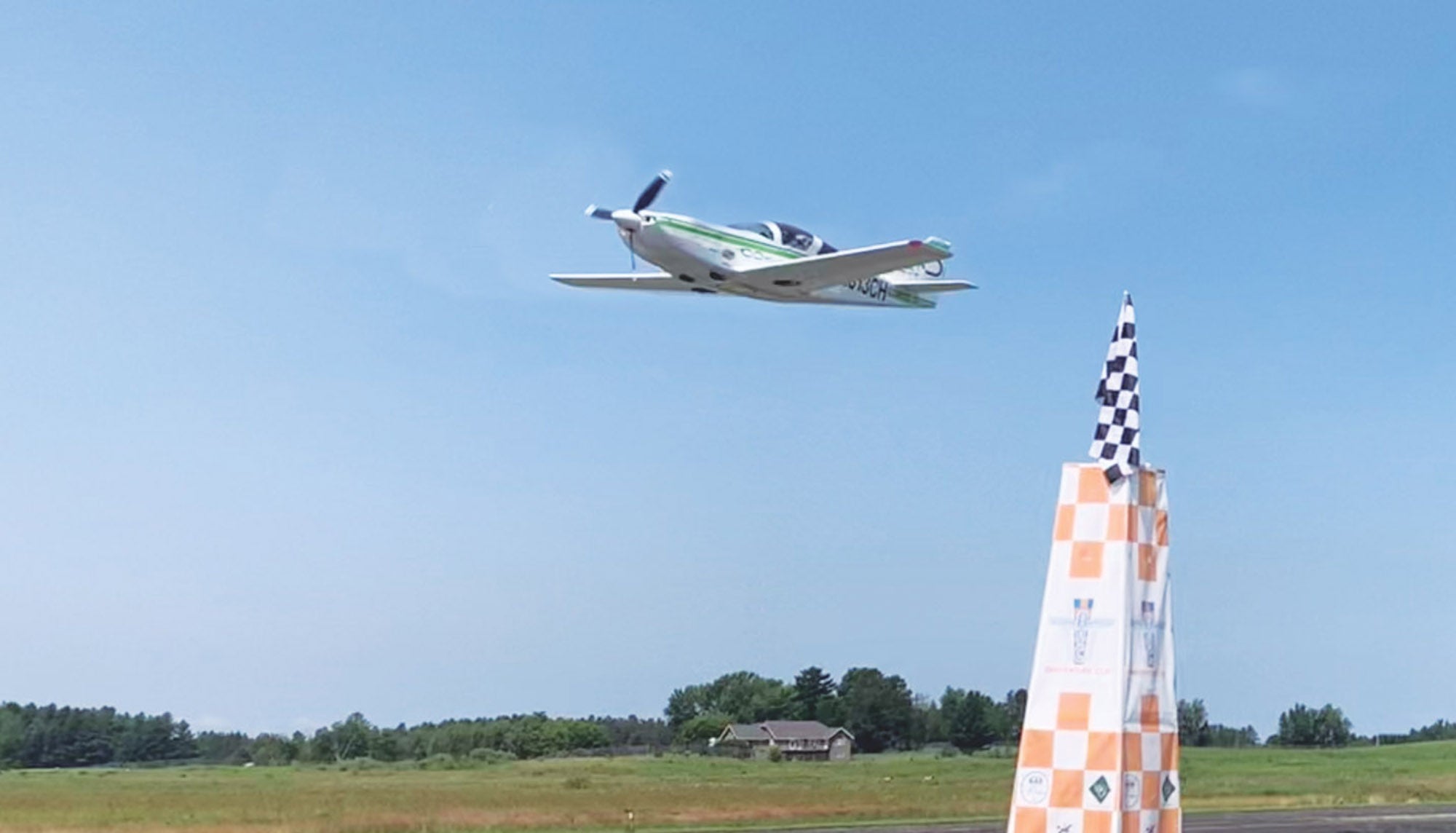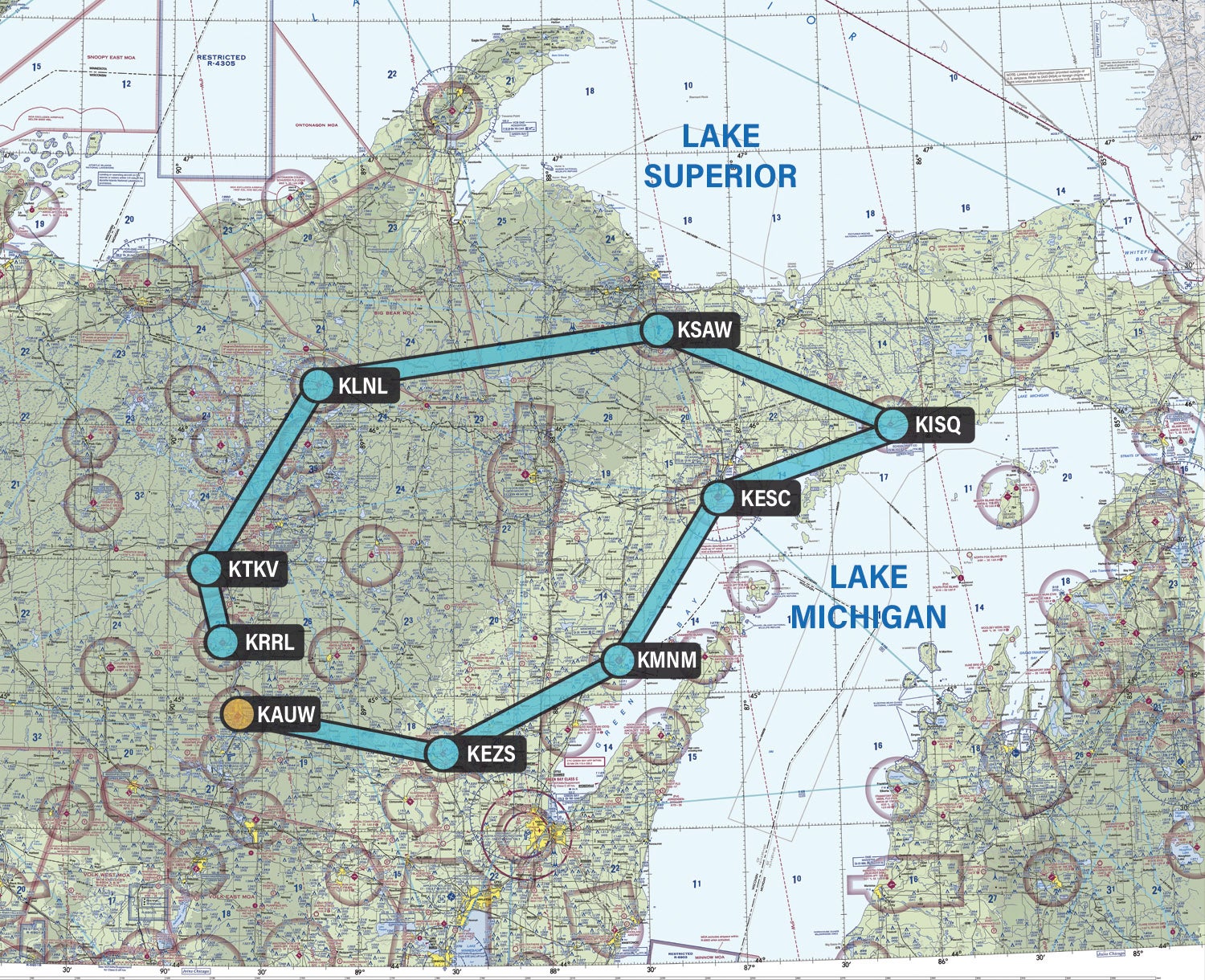
Started in 1997 by Eric Whyte and Erik Anderson, the AirVenture Cup offers its own twist on the traditional point-to-point air race. Namely, it is not run in a straight line, but in a series of straight legs forming a circle. This allows participants to end up where they started, reducing logistical headaches and easing the transition from AirVenture Cup on Sunday to hopping down to Oshkosh for AirVenture proper by Monday.
Still, this is a cross-country race covering 430 miles, so something more reliable than thumbscrew power settings and the-world-ends-in-20-minutes fuel consumption are required. Lately, Sport pylon racers saw that simply pulling back the loud lever could make them good cross-country racers as well, so a majority of the faster Sport folks joined the already multi-class AirVenture Cup this year.
Curious how these kitbuilt speedsters would cope in the real-world AirVenture Cup, I made a nuisance of myself by hitching a ride with an indulgent Tim Slater. Tim is the president of the Sport class and makes do with a mere naturally aspirated 580-cubic-inch, 10:1-compression Lycoming in his Glasair III, compared to the twin-turbo wunderwaffen headlining the Sport Gold ranks. Perfect, in other words, to demonstrate what a well-developed but still financially possible sportster can do as a going-places airplane.
My AirVenture Cup experience began with a cascading disaster of canceled, delayed and missed-connection airline flights, so I arrived at the Wausau starting airport after 2 hours, 55 minutes of sleep the night before. I wasn’t exactly on my A-game, which isn’t to ignore my hangar partner’s position that at our age we no longer have an A-game, but it did underline a powerful reason to aspire to one of these fast cross-country airplanes: to take your destiny back from the airlines.
Seeing the 85 AirVenture Cup entries on the Wausau ramp did much to perk me up, along with so many familiar faces at the pre-race briefing. This was a blessedly informal yet informative meeting run long enough to cover everything, yet without the deadening officialdom common to those impressed with their purpose. With the race planes already tightly spotted on the Wausau ramp, it was a short time from briefing to a group photo, colors, then saddling up and engine start.
Personally, it was a moment for me. Since 1982 I’ve crewed on air race teams, spectated or documented air racing as a journalist, but this was the first I’d ever slithered down into a cockpit and taxied out for a start. Just seeing the colorful airplanes packed on the ramp and knowing I was going flying with them was a milestone.

to Oshkosh later that afternoon.
Line Up and Go!
Before the emotion wore off, we were lining up on Wausau’s Runway 13 and watching the planes in front of us speed off into the distance. The race start is much like departing AirVenture midweek save for the adrenaline expresso that comes with a green flag. The airplanes funnel onto the runway in pairs, taking alternate sides. A flagman signals ready, then launches about as fast as the previous aircraft rises off the asphalt. Inside Tim’s Glasair there was the last-minute checking, then the short wait for the start followed by the hectic throttle-in and instrument scan ensuring all the moving parts were happy. We accelerated, climbed (not much!) and set course toward the first turn point: Shawano. We also began what would be a race-long traffic scan.
My initial impression was we were at pattern altitude plus a little so there wasn’t much sensation of speed, but the checkpoints slid over the horizon noticeably faster than my cross-country biplane! I’m used to looking a bit past the cowling for the next airport, but in the Glasair one peers regionally into the haze to hopefully pick out the different color patch signifying the next flugplatz.
Another rapid realization was how busy it is commanding one of these hot rods in a competitive environment. Most of the time traffic was not an issue in the traditional sense, but keeping track of the race—and sometimes race traffic—via ForeFlight and an iPad was the default neck stretcher. Equally demanding is playing human engine management computer. Tim’s six-cylinder sports SDS electronic fuel and ignition, the most popular system with the go-fast Sport racers. It allows leaning cylinder by cylinder in real time, so there’s quite the urge to either fiddle with the overall A/F ratio or fine trim the fuel per cylinder using a menu and up and down keys on the SDS display. I would not call it hectic, but Tim stayed busy.
Of course there was the expected question of either climbing for smoother air or more favorable winds, or saving the climb time and toughing it out down low. With 10:1 pistons there’s a little more workable altitude to consider than with stock compression, but nothing like the turboed competitors who could makes sense of 17,500 feet, winds willing. Light winds during our race made altitude choice more about turbulence.
Except for the first two checkpoints, the race is run to a minimum of 1000 feet AGL, and ADS-B keeps everyone honest. As for the first two airports, they had spectator areas so competitors were required to overfly the runways no lower than 200 feet and no higher than 500 feet so people can see the planes. The appropriate waivers made it kosher with the FAA.
Fuel burn is vitally important and the eternal question of slowing down and going nonstop or pushing up the power and making a fuel stop remains. AirVenture Cup rules allow one, no-time-penalty fuel stop, and the faster planes take advantage of this. We made our stop in Manistique, Michigan, and it was a fur ball with a non-towered field fully open to local traffic, race traffic passing overhead and a good number of those racers circling around to land and take off on runways with no taxiways, so back taxiing was the norm. Eyes were definitely outside the cockpit there; it was the one time I might have been of some use.
The last thing I’ll mention was the cockpit heat although it was hardly he-man stuff. More than one V-8 race car I’ve pedaled reached over 140° F in the cockpit and that’s a real factor. No, the heat in Tim’s plane was both some local source wanting to cook my left ankle and a general warmth from running the engine at high power. The bubble-like canopy doesn’t help, three hours of sleep the night before ditto, and the fact that everyone wears shorts, polo shirts and no helmets makes cooling easier. Still, speed means burning fuel, which means extra waste heat, and it’s worth erring on the side of excess cockpit cooling if you’re building for long, fast cross-countries. The folding cockpit shade cover was a big help until we caught it in the cockpit door at the fuel stop such that it wouldn’t extend fully.
By the Numbers
Tim did great, finishing an exceedingly close second to Joe Coraggio in Sport, who was in a naturally aspirated Lancair. Tim ran 29 inches of manifold pressure (nice ram air inlet) up to the refueling stop at Manistique, then dialed it back to an average of 28 inches the rest of the way. The real fiddling was with the air/fuel ratio, which Tim measures directly via an oxygen sensor. This is typical of Sport racers who prefer A/F numbers to EGT measurement. He ran as rich as 11.5:1 at 5500 feet, but most of the time leaner, varying the mixture cylinder by cylinder. In fact Tim had melted a cylinder the week prior to the race, so we were breaking in the new Number 6 during the race and he could keep a close watch—and tuned the fuel on just that one cylinder. The overall technique is to lean the mixture to best power while using the CHT reading as the limit.
That said, temperatures were normal throughout the race, signifying an excellent cooling system. CHTs varied from 370° to 390° F depending on the A/F ratio and altitude (later in the race we ran at 5500 feet). The oil eventually stabilized at 215° F, which is a perfect racing temperature although you could add 5° F to all temps at 3000 feet or lower, probably because the engine makes more power in thick air. Tim has spray-bar water cooling for pylon racing but used it only once late in the AVC during a climb to ensure the CHTs didn’t go over 400° F. A quick shot of spray water did the trick very effectively.
This was Tim’s first long-distance race and he averaged 28 gph fuel burn or “Way more than I thought.” As always, speed costs money.
For comparison Tim’s normal cross-country numbers are 23 inches/2350 rpm at 11 gph lean of peak, or approximately 17:1 A/F ratio. This yields 230 KTAS at 10,000 to 13,000 feet. With 60 gallons on board he’s run the 1050 nautical miles from Las Cruces, New Mexico, to his home in Poplar Grove, Illinois, in 4 hours, 45 minutes. That’s 1200 statute miles nonstop at 265 mph. By comparison in the AVC we ran 430 miles at 287 mph, but it took another 17 gph to gain the extra 22 mph down low. Life, it seems, remains full of choices.













